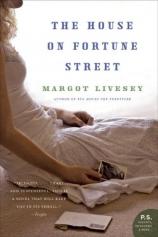The House on Fortune Street: A Novel
Review
The House on Fortune Street: A Novel
Margot Livesey's ambitious, affecting seventh novel, THE HOUSE ON FORTUNE STREET, is the kind of book that probably sounds bizarre or disjointed in any kind of brief plot description. And, in the hands of any less capable novelist, it probably would be either spectacularly dull or maddeningly confusing. But in award-winning author Livesey's unified, compelling vision, somehow this achingly sad but beautiful work of fiction not only makes sense but also creates meaning for its readers.
The novel is made up of four interconnected novellas, united by the character of Dara MacLeod, a young woman who, in the opening story, is struggling to find her own romantic happiness despite her involvement with a distant, married man and her sense of dissatisfaction with her own life compared to that of her best friend Abigail and her partner Sean, who has recently left his own wife to move into Abigail's house on Fortune Street, where Dara also rents an apartment from Abigail.
However, in this opening section, which focuses on Sean, readers learn what Dara doesn't even suspect --- that all is not perfect in Sean and Abigail's relationship. Abigail has grown obsessed with getting her fledgling theater company off the ground, rarely coming home to Sean, whose professional dissatisfaction (he is a literary scholar who can't seem to finish his dissertation) appears to mirror his frustrations with their relationship. Sean's fascination with Dara's seeming emotional openness and availability --- so in contrast with Abigail's --- remains distant until a tragedy and a betrayal shake the house's very foundations.
The second novella shifts direction suddenly to Dara's childhood, and more specifically to her father, Cameron, who narrates the tale. He writes of his own long-kept secret, one that he has never been able to share with Dara --- a fascination with young girls (particularly Dara's best friend) that borders on the erotic. Cameron never acts on his desires but finds himself unable to acknowledge the truth about himself and the reason for his divorce to Dara, even as an adult.
Dara herself, and particularly her initial meeting with her married lover Edward, forms the basis for the third novella. By this point in the novel, readers know a great deal about Dara, along with the people and places that have made up her past. When this third section relates Dara's relationship anxieties, her troubled reconciliation with her father and her rocky friendship with Abigail, audiences will find themselves putting the pieces of Dara's life together, at times cringing at the uncomfortable realities that the more complete picture depicts.
Finally, the fourth section focuses on Abigail. In many ways, Abigail has been a cipher throughout the novel; more talented than her boyfriend Sean, more confident than her best friend Dara, Abigail has been the lucky one to whom both more vulnerable characters compare themselves. In Abigail's own story, however, which starts in childhood and extends to the present (revealing the heartbreaking reasons for Dara's fate), we learn that no one --- not even Abigail --- can really escape the foundations of their past and the consequences of their bad decisions.
THE HOUSE ON FORTUNE STREET is fascinating on many levels. From a narrative point of view, the way in which Livesey transforms Dara from a marginal character in the first novella to the emotional heart of the whole novel is a brilliant exercise in storytelling proficiency. From a literary point of view, Livesey manages to subtly integrate four different British literary figures --- from Keats and Charles Dodgson to Charlotte Brontë and Charles Dickens --- into the lives of her characters, at times drawing explicit parallels but more often trusting her readers to make the connections themselves (thereby delighting thousands of English majors worldwide). Finally, from an emotional point of view, Livesey capably draws such compelling portraits of so many fundamentally flawed characters that readers will become invested not only in Dara's central, heartrending story but also in the lives of all those whose experiences have shaped her own.
Along the way, Livesey encourages thoughtful reflection on difficult questions: Where does the truth lie? What is the importance of the stories we tell about our own and others' lives? What do our difficult decisions say about our fundamental character? Is it possible to walk away from one's past? Much as the four stories here form a sort of dialogue with one another, THE HOUSE ON FORTUNE STREET is a novel that lends itself perfectly for ongoing dialogue in book clubs or more casual conversations between lovers of great stories --- the classic and the contemporary.
Reviewed by Norah Piehl on May 5, 2009
The House on Fortune Street: A Novel
- Publication Date: May 5, 2009
- Paperback: 311 pages
- Publisher: Harper Perennial
- ISBN-10: 0061451541
- ISBN-13: 9780061451546





